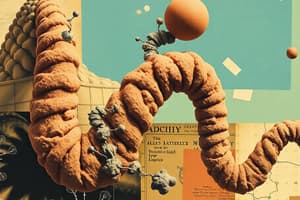Podcast
Questions and Answers
What type of bonds hold subunits together in a protein?
What type of bonds hold subunits together in a protein?
Hydrogen bonds and van der Waals forces between nonpolar side chains
What is denaturation of proteins?
What is denaturation of proteins?
The process of modifying the conformation of protein structures without rupturing the native peptide linkages
What is the net charge of a zwitter ion?
What is the net charge of a zwitter ion?
Zero
What type of protein catalyzes biochemical reactions in cells?
What type of protein catalyzes biochemical reactions in cells?
What is the process of converting a denatured protein back into its native 3D structure?
What is the process of converting a denatured protein back into its native 3D structure?
What are the functional groups present in amino acids that make them zwitter ions?
What are the functional groups present in amino acids that make them zwitter ions?
What type of protein makes various structural components of living beings?
What type of protein makes various structural components of living beings?
What is the effect of denaturation on the biological activity of proteins?
What is the effect of denaturation on the biological activity of proteins?
What is the primary function of transport proteins?
What is the primary function of transport proteins?
What type of protein provides a defensive mechanism against pathogens?
What type of protein provides a defensive mechanism against pathogens?
What is the primary function of contractile or mobile proteins?
What is the primary function of contractile or mobile proteins?
What is the difference between fibrous and globular proteins?
What is the difference between fibrous and globular proteins?
What is a conjugated protein?
What is a conjugated protein?
What is the function of storage proteins?
What is the function of storage proteins?
What is a metalloprotein?
What is a metalloprotein?
What is the function of regulatory proteins?
What is the function of regulatory proteins?
What is a prosthetic group in a protein?
What is a prosthetic group in a protein?
What are derived proteins, and give an example.
What are derived proteins, and give an example.
What is a non-standard amino acid found in collagen?
What is a non-standard amino acid found in collagen?
What is the function of γ-Carboxyglutamic acid in certain plasma proteins?
What is the function of γ-Carboxyglutamic acid in certain plasma proteins?
What is the role of D-Penicillamine in the treatment of Wilson's disease?
What is the role of D-Penicillamine in the treatment of Wilson's disease?
What is the significance of histones in protein structure and function?
What is the significance of histones in protein structure and function?
Flashcards are hidden until you start studying
Study Notes
Protein Structure
- Each subunit of a protein has its own primary, secondary, and tertiary structure.
- Subunits are held together by hydrogen bonds and van der Waals forces between nonpolar side chains.
Denaturation and Renaturation
- Denaturation is the process of modifying a protein's conformation without rupturing native peptide linkages.
- Denaturation inactivates protein functionality, decreases solubility, destroys biological activity, improves digestibility, and alters water binding ability.
- Denaturation can be achieved by applying heat, treatment with alcohols, heavy metals, or acids/bases.
- Renaturation is the conversion of a denatured protein back into its native 3D structure.
- Renaturation is sometimes reversible, but not as common or easy as denaturation.
Zwitter Ion
- A zwitter ion is a molecule with functional groups that have both positive and negative electrical charges, resulting in a net charge of zero.
- Amino acids are the best-known examples of zwitter ions, containing an amine group (basic) and a carboxylic group (acidic).
- The -NH2 group is the stronger base, picking up H+ from the -COOH group to form a zwitter ion.
Classification of Proteins based on Biological Functions
- Catalytic proteins: catalyze biochemical reactions in cells (e.g., enzymes and co-enzymes).
- Structural proteins: make various structural components of living beings (e.g., collagen in bones, elastin in ligaments, and keratin in hair and nails).
- Nutrient proteins: have nutritional value and provide nutrition when consumed (e.g., casein in milk).
- Regulatory proteins: regulate metabolic and cellular activities in cells and tissues (e.g., hormones).
- Defense proteins: provide defensive mechanisms against pathogens (e.g., antibodies and complement proteins).
- Transport proteins: transport nutrients and other molecules from one organ to another (e.g., hemoglobin).
- Storage proteins: store various molecules and ions in cells (e.g., ferritin storing iron).
- Contractile or mobile proteins: help in movement and locomotion of various body parts (e.g., actin, myosin, and tubulin).
- Toxic proteins: are toxic and can damage tissues (e.g., snake venom and bacterial exotoxins).
Classification of Proteins based on Chemical Composition
- Simple proteins:
- Fibrous proteins (e.g., collagen).
- Globular proteins (e.g., albumin).
- Conjugated proteins:
- Nucleoproteins (protein linked to a nucleic acid, either DNA or RNA).
- Glycoproteins (carbohydrate covalently linked to protein).
- Lipoproteins (lipid and protein).
- Phosphoproteins (protein with a phosphate group attached).
- Chromoproteins (protein with a pigmented prosthetic group, e.g., hemoglobin).
- Metalloproteins (enzyme proteins containing metallic elements, e.g., iron, copper, and cobalt).
Derived Proteins
- Derived proteins are derivatives of either simple or complex proteins resulting from the action of heat, enzymes, and chemicals.
- Examples include albumose (derived from albumins).
Non-Standard Amino Acids
- Besides the 20 amino acids present in protein structures, there are several other biologically important amino acids.
- Examples include:
- 4-hydroxyproline and 5-hydroxylysine in collagen.
- Methylated, phosphorylated, or acetylated amino acids in histones.
- γ-Carboxyglutamic acid in certain plasma proteins involved in blood clotting.
- D-Penicillamine (D-dimethylglycine), a metabolite of penicillin, used in chelation therapy of Wilson's disease.
Studying That Suits You
Use AI to generate personalized quizzes and flashcards to suit your learning preferences.




